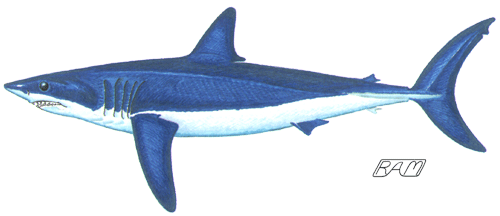How Fast Can a Shark Swim?
Sharks typically swim with the even, liquid grace of a creature completely at home with its place in the Universe. Large sharks generally cruise at a leisurely 1.5 miles (2.4 kilometres) per hour. Because most species fare poorly in captivity, the maximum swimming speed of a shark has seldom been measured. The Blue Shark (Prionace glauca) is an open ocean glider, planing on wing-like pectoral fins and flattened belly. There exists a dubious record of a small Blue Shark about 2 feet (0.6 metres) in length which was found to swim steadily against a current at 17.7 miles (28.5 kilometres) per hour and was reported to achieve 43 miles (69 kilometres) per hour in short bursts. The most reliable record of a Blue Shark at speed is 24.5 miles (39.4 kilometres) per hour for a 6.5-foot- (2-metre-) long individual.

The Shortfin Mako (Isurus oxyrinchus) is probably the champion speedster among sharks. It is an open ocean sprinter, with a highly streamlined body, a lunate tail supported by keels, a sharply pointed snout, large eyes and some of the wickedest-looking teeth in sharkdom. Like the White Shark (Carcharodon carcharias) and a few of its lamnoid relatives, the Shortfin Mako has a jury-rigged circulatory system which enables this species to retain metabolic body heat, making it functionally warm-bodied. It is also a spectacular and much sought-after gamefish, often leaping repeatedly when hooked. Among sport anglers, this explosive activity combined with dazzling ultramarine flanks has earned the Shortfin Mako the dramatic honorific, "Blue Dynamite". Famed western author and big game angler Zane Grey held this species in particularly high regard, noting that hooked Shortfins typically leap in sets of three, with the third leap usually the highest — sometimes as much as 15 to 20 feet (5 to 6 metres) above the surface. Calculations show that for a mako to leap 20 feet (6 metres) into the air, a speed of 24.6 miles (39.6 kilometres) per hour is required — and this for a shark impeded by the drag of a fishing line trailing from its mouth.
Underwater and unimpeded by a fishing line, the Shortfin Mako has been reliably clocked at 31 miles (50 kilometres) per hour, and there is a claim that one individual of this species achieved a burst speed of 46 miles (74 kilometres) per hour. But it is extremely difficult to get a fish in the wild to swim in a straight line over a measured course. Laboratory measurements of numerous kinds of fishes — representing a wide range of body sizes — swimming against an artificial current have revealed a surprisingly uniform maximum burst speed of about 10 times the body length per second. Thus, for an average-sized, 6.5-foot (2-metre) Shortfin, its theoretical maximum speed might be something on the order of 45 miles (72 kilometres) per hour. Yet some estimates of the top-speed of a Shortfin Mako are considerably higher.
In an effort to determine the maximum swimming speed of the Shortfin Mako, two New Zealand researchers undertook a simple experiment which yielded astonishing results. Off the coast of Auckland, aquarist Craig Thorburn and film-maker Mike Bhana videotaped a 3-foot (1-metre) juvenile Shortfin Mako — estimated to be about one year of age — chasing a baited camera trolled behind their boat. The shark seemed to have no trouble keeping up with the towed array at medium speeds, so the researchers decided to accelerate to see just how fast the little Mako could go. From this experiment, Thorburne and Bhana estimate that the shark accelerated from a dead stop to cover a distance to the bait of more than 100 feet (30 metres) in just two seconds.
If, as Thorburn and Bhana attest, the shark did indeed start from a standstill — which seems behaviorally unlikely — to cover the stated distance in the stated time, the little Mako must have achieved an acceleration of at least 50 feet (15 metres) per second, per second. This acceleration rate rivals that of the very fastest sport cars and seems rather improbable. Nevertheless, using this figure as the constant rate of acceleration, calculations suggest that by the time this little Mako reached caught up with the bait, it reached a top speed of about 68 miles (110 kilometres) per hour! But it should be stressed that if any of Thorburn and Bhana's estimates (the shark's initial speed, the actual distance covered, the time required to reach the bait, etc.) is inaccurate, this startling figure could be 'off' by quite a bit.
Not surprisingly, Shortfin Makos are able to catch even the fastest of fishes — there is a record of a 750-pound (340-kilogram) Mako with a whole 120-pound (54.5-kilogram) Broadbill Swordfish (Xiphias gladius) in its stomach; however, it is uncertain whether the shark out-sprinted or out-maneuvered the swordfish. The White Shark is one of the sea's paramount predators, able to catch and consume such speedy prey as tunas, sea lions, and dolphins. It is therefore natural to wonder about its top speed.
Unfortunately, no one has yet measured the swimming speed of a White Shark going flat-out. Analysis of White Sharks attacking a video camera-equipped surfboard off the South Farallon Islands, California, give some indication of this animal's attack speed. Current consensus among shark scientists is that the top swimming speed of the Great White is at least 25 miles (40 kilometres) per hour. My own rough, back-of-the-envelope-type calculations — using several methods — suggest that the White Shark may achieve burst speeds of 35 miles (56 kilometres) per hour or more. That may not seem very speedy, but it's seven times faster than the finest Olympic swimmer and probably at least ten times faster than you or I could manage.
To compare the top speeds of sharks with those of
other swimming
creatures, see "Haulin' Bass"
